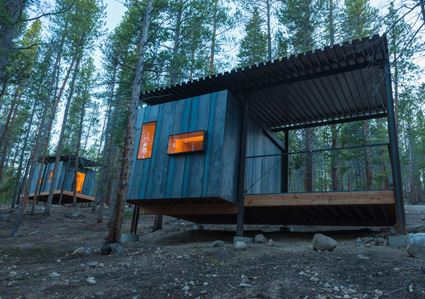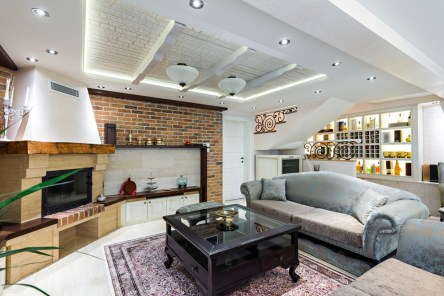With an eye towards sustainability and passive building principals, University of Colorado Denver’s prefab, cabin-style dorms connect modern architecture with outdoor living. Just outside Denver, Colorado sits a cluster of 14 micro dormitories outfitted with all the essentials necessary for comfortable, environmentally-friendly cabin living. Created in partnership with Outward Bound, the micro dorm project was developed by 28 University of Colorado Denver, graduate students participating in CU-Denver’s Colorado Building Workshop. Hands-On and Creative Established in 1991, the Colorado Building Workshop began as part of an effort to pair non-profits with innovative architectural projects. With an emphasis on promoting hands-on skills and creative design, workshop participants use cutting-edge materials and inventive design to produce buildings for disadvantaged communities. Graduate students from CU-Denver’s Studio IV must apply to be part of the workshop. If accepted, they are required to complete 18 credit hours of the Design Build Certificate. The course of study emphasizes both the basics of Design Build and Integrated Project Delivery. The program’s courses cover topics focused on quality and risk management, along with group assignments requiring students to work together to shepherd a project from initial concept to completion. “Collaboration is the core principle of the design-build program,” declares the program’s website. “We are thankful to all the businesses and individuals who support this work and recognize its importance in the local community.” Two Structures, One Footprint Rick Sommerfeld, founder and director of Colorado Building Workshop, set out with his students to create living spaces capable of coexisting with the land. As a result, their final design make the most of open-air entry-points while also providing basic living quarters. With front-facing decks and floorplans that “sit lightly on the landscape,” each individual unit balances private and community spaces. Surrounded by pine forest and...
StratIS
Tech for Student Housing
Tech and college students go hand-in-hand. That hasn’t always been the case for tech and student housing. This sector of multifamily housing has experienced a lag in affordable products that bring energy management and automation into the modern technological environment. StratIS is quickly changing that. BuLogics, a campus leaders in wireless solutions for the Internet of Things, developed StratIS in 2013. StratIS facilitates varying degrees of remote control for energy usage, home automation, and access to residential units. Users can also submit maintenance requests using the app. For unit access, StratIS partnered with Schlage hardware company to create Control Smart Locs with ENGAGE. This technology is ideal for multifamily applications: ENGAGE permits lock control through the cloud-based StratIS app. Through this network, staff can now remotely issue replacement credentials, grant vendor access, and complete audits without entering into the field. StratIS operates in more than 72,000 multifamily and hospitality units in nearly 300 properties throughout the U.S. Student housing units make up approximately one third of StratIS properties. The system has quickly grown popular with student housing owners and managers thanks to three key components: Low Costs Popular energy and access management systems of this type are often cost prohibitive for the owners of smaller buildings. The relatively low cost of StratIS technology opens the arena of advanced management tools to owners of properties with smaller footprints. Quick Returns StratIS claims a two-year return on investment for its wireless solutions. The company also reports a 20 percent reduction in energy consumption before demand response capabilities. Easy Installation StratIS offers ultra-simple product installation. CEO Felicite Moorman told Building Design + Construction, “I also test everything on my seven-year-old, and if she can’t use it, we try to figure out what happened.” The company’s innovative approach...
Luxury Student Housing...
Upward Trend or Doomed Fad?
Student housing has grown into a $5 billion industry. Colleges and universities rely on private builders for housing, on and off campus. These private builders are best able to equip units with features that appeal to the new generation of student renters while keeping the institutions’ costs low. Yet with the rise of student debt and the accompanying public outcry, the glory days of luxury student housing may be short-lived. The dorms of today are nothing like what I grew up with at my private institution—and I’m barely 30. For freshman year, I shared a tiny, cinderblock room with a roommate. 15 rooms on our hall shared a commercial-style bathroom. If it weren’t for the laughter in the halls and all of the pretty decorations, we could’ve been confused for inmates. While the accommodations improved as I gained seniority, even some of the nicer rooms at my college pale in comparison to new student housing. Today’s freshmen face serious temptation. Common amenities are leaning more towards the luxurious than the utilitarian: saunas, steam rooms, tanning beds, infinity pools, lazy rivers, maid service, dietary-savvy restaurants, and onsite clubs are not uncommon in student housing throughout the nation. The College Board reports that the average cost of room and board in 2014-2015 was $9,804 for state schools and upwards of $11,000 at private schools. Students are high-risk tenants, so housing comes at a price, especially if you want a nicer lifestyle. Just how are students paying for these high rents? They aren’t. That’s part of the problem with the public’s reception of student housing. Students are digging themselves into debt at backbreaking rates. Most students aren’t working their way through college in the traditional sense. They aren’t working directly to cover expenses and graduate debt free. If they aren’t receiving...



